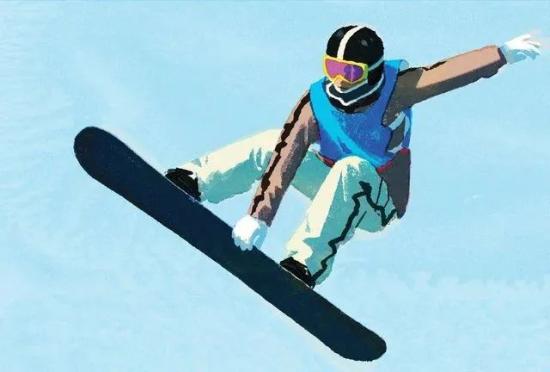How much do you know about skiing safety precautions?
You need to know before skiing
warm up
"The temperature in the ski resort is low, and the skier’s body is extremely stiff. If the joint muscles can’t move, it is easy to get hurt. It is suggested that beginners should do enough warm-up activities before going on the snowy road, especially the joints such as hip, knee, ankle and wrist. "
The doctor said that the purpose of preparation activities is to promote blood circulation through basic movements, so as to reduce the viscosity of muscles, enhance muscle strength, increase the flexibility of joints, improve the excitability of the central nervous system and the functions of various organ systems of the body, and then make the movements more coordinated and accurate.
protective appliance
As a beginner, the most important thing is to ensure your own safety before skiing. Wear a helmet of appropriate size, hip pads and knee pads. You should wear protective gear to protect yourself when skiing, regardless of your skiing level.
keep warm
Skiing is a sport in a cold environment, so heat preservation is particularly important, and people are prone to frostbite accidents when exposed to low temperature for a long time. According to the survey report, not paying attention to keeping warm and warming up is the main cause of injuries in the snow field. In the low temperature environment, if the body is cold and stiff, it is easy to fall down, and if there is no heat supplement for a long time, it will be frostbitten. You can take some drugs with you, such as nitrofurazone hydrocortisone lotion and 741 frostbite cream. Don’t learn to rub frostbitten parts with snow in film and television dramas. It is best to soak them in warm water and then go to the hospital for examination and treatment.

equipment
① Clothes: The color should be bright or have a big contrast with the snow surface, so as to be easy to identify and avoid collision. In addition, you should prepare an extra winter coat and two underwear. When the clothes are wet by snow or sweat, you can change them in time to prevent colds.
② Ski goggles: Due to the strong sunlight reflection in the snow, you must wear colored glasses to protect your eyes. It is recommended to wear resin glasses with frames as much as possible, and the lens color is better in yellow or brown.
3 Helmets, gloves and face protection: For safety reasons, helmets must be worn. Skiing is fast and windy, so warm gloves against wind are also essential. You can put on your face first and then your helmet. In addition, the winter weather is generally dry and windy, and face protection can effectively protect facial skin.
4 socks: It is best to wear ski socks when skiing, and longer wool socks are the best. Because ski boots are all high, socks are too low, and the skin is in direct contact with the inner boots of snowshoes, which is easy to cause swelling and pain due to friction. It’s best to prepare two or three pairs of socks. Beginners often fall down, and snow can easily get into shoes and wet their feet. At this time, you need spare socks.
⑤ Water Cup: Free boiled water is usually provided at the rest place of the snow field. Bring a water cup to quench your thirst and warm yourself up.
ultraviolet ray
It is cold and dry in winter, and the skin loses water quickly in this climate condition. In addition, the skin is stimulated by the relatively high-speed cold wind formed during skiing and burned by the strong ultraviolet rays reflected from the snow, which are the main causes of skin injury. In order to prevent the loss of water and the skin from being burned by ultraviolet rays, some oily skin care products with the function of preventing the loss of water can be selected, and then a sunscreen cream with good anti-ultraviolet effect and water resistance can be applied to the skin. Sunscreen can only be effective for a short time, so it should be applied to the exposed skin once every once in a while (usually 2 hours). You must not apply sunscreen because it is cloudy, because the ultraviolet rays are still very strong on cloudy days.

partner
It’s best not to go skiing alone, so as to avoid accidents that no one knows and no one rescues. Besides, you must tell your family and friends where you are going skiing and when you will be back. Remember not to leave yourself alone and follow group activities.
wrestling
Learning the correct falling posture can try to avoid serious injuries! Sit down to the left or right. Never sit directly behind, and you can’t sit on the ground with your hips directly behind. Put your hands on your sides to avoid being crushed by your hips. Don’t support the ground with your palms. After the buttocks touch the ground, the steel edge of the snowboard will also scratch the snow to cause resistance and prevent sliding. If you fall down out of control during taxiing, you should immediately lower your center of gravity, sit back, and don’t struggle at will. You can lift your limbs, bend over and let them fall, avoid falling head down, and absolutely avoid tumbling.
diet
Skiing is a very physical exercise. The calorie storage capacity of human body is generally 1,500-2,000. Outdoor skiing consumes calories very quickly, generally consuming 600 calories per hour, which means that the calories will be exhausted in two or three hours at most.
Moreover, it is not advisable to eat too much before skiing, otherwise the burden on the stomach during exercise will be too large, which will easily lead to nausea and vomiting. Choose a carbohydrate-rich food, rice or pasta, with vegetables and meat, and use snacks to supplement calories during skiing, such as chocolate, beef jerky, Snickers, walnuts, peanuts and other nuts.

You should know in skiing.
1. Before skiing, you should know the length, width, height, slope and direction of the snow trail, so as to avoid being caught off guard in case of an accident during skiing.
2. Choose the snow trail according to your own level, and never overestimate yourself.
3, to understand the climate characteristics and weather conditions of the snow field, pay attention to the sudden change of weather.
4. When skiing, you can’t stop on a steep slope. You should stop on the edge of a slow snow trail and pay attention to the skiers who slide down. If you don’t know the situation ahead or feel that the ski equipment is abnormal when skiing, you should check it in time.
5, pay attention to distance when taxiing, don’t catch up with your partner, so as not to fall or collide.
6. If you find someone injured, don’t move it at will. You should call the snow rescue immediately.
7. Priority of ski trails. Skiers in the leading position have priority to use ski trails compared with other skiers, who must keep a safe distance from the skiers in front. If there is a collision in skiing, the responsibility will be borne by the skiers behind;
8. When the speed and balance cannot be effectively controlled, you should take the initiative to fall to the rear;
9. When overtaking, sufficient safety space must be reserved for the normal sliding of the overtaken;
10. Non-skiers are forbidden to enter the ski run;
11, it is forbidden to drink skiing, it is strictly prohibited in the crowd gathered, narrow road surface speed skating slope;
12, pay attention to watch the snow tips, warning signs, tips, etc., and strictly follow the requirements.

Ten safety guidelines of the International Snow Federation
1. Respect principle
Both snowboarders and snowboarders should follow the following code of conduct: never do anything that will hurt or cause others to get hurt.
2, the principle of self-control
Both snowboarders and snowboarders should keep their skiing within the controllable range. The speed and mode of skiing should be consistent with the individual skiing level, and the mode of skiing should be selected according to the terrain, snow quality, weather and population density of the ski resort.
3, choose the principle of safe line
Skiers in the rear must choose a route that does not endanger the skiers in front. (Skiers in front have priority in using the snow trail)
4. Overtaking principle
Please keep enough distance when overtaking other skiers from the rear or side.
5, into the snow, start, climb the principle
When skiing is resumed after a short break, or when climbing up a slope, be sure not to endanger yourself and others.
6, stop location principle
Unless necessary, skiers should avoid staying in the middle of snow trails, racetracks, narrow snow trails and places where the line of sight is easily blocked. If you pass through the above places, please pass as soon as possible.
7, the principle of walking on both sides
If you need to walk on the snowy road, please be sure to walk on both sides of the snowy road.
8. Pay attention to the principle of warning signs.
Skiers are requested to pay enough attention to signal boards, signs and indicators.
9, the principle of assistance
In the event of an accident, every skier has the obligation to help the injured.
10, accident identification principle
Skiers or witnesses after the accident, regardless of whether they are responsible or not, should leave contact information with each other.
When you gallop in the vast snowfield in a brightly colored ski suit, it is like a flower in a snow-white petal, which is pleasing to the eye. When you fly down a high slope, feel the unique charm brought by skiing, and you will definitely fall in love with this sport!
Original title: "How much do you know about skiing safety precautions? 》